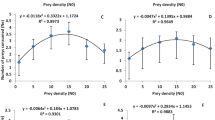Abstract
This study investigates the effects of pederin, a hemolymph toxin that is accumulated in the eggs of most Paederus females, on potential arthropod predators of the offspring of P. fuscipes and P. riparius. Insects generally do not respond to pederin present in the prey. Paederus larvae are sufficiently agile to escape from these predators by running away, and the eggs are hidden by the females. Unlike insects, (wolf) spiders are deterred by prey with pederin. They turn away from larvae they have already captured and exhibit cleansing behavior. Larvae containing pederin survive the attacks of spiders without damage, whereas larvae descended from females that do not transfer pederin into their eggs are often killed and eaten. In the case of sudden attacks by spiders, the larvae have no chance of escape. Their survival thus depends on chemical defense. These investigations show for the first time why pederin might be of considerable importance for Paederus in the field.
Similar content being viewed by others
References
Boháč J (1985) Review of the subfamily Paederinae (Coleoptera, Staphylinidae) in Czechoslovakia. Acta Entomol Bohemoslov 82: 360–385
Cordes D (1991) Phänologie und Lebenszyklus von Wolfsspinnen (Araneae: Lycosidae) auf Wirtschaftswiesen des Altmühltals/Bayern. Arachnol Mitt 2: 1–19
Dettner K (1987) Chemosystematics and evolution of beetle chemical defenses. Annu Rev Entomol 32: 17–48
Eisner T, Eisner M (1991) Unpalatability of the pyrrolizidine alkaloid-containing moth Utetheisa ornatrix, and its larva, to wolf spiders. Psyche 98: 111–118
El-Heneidy AH, Abbas MST (1984) Population dynamics of certain insect predators associated with aphids in maize fields in the Giza region. Beitr Trop Landwirtsch Veterinärmed 22: 407–413
Ford MJ (1978) Locomotory activity and the predation strategy of the wolf-spider Pardosa amentata (Clerck) (Lycosidae). Anim Behav 26: 31–35
Frank JH, Kanamitsu K (1987) Paederus, sensu lato (Coleoptera: Staphylinidae): natural history and medical importance. J Med Entomol 24: 155–191
Freude H (1976) Carabidae (Laufkäfer). In: Freude H, Harde KW, Lohse GA (eds) Die Käfer Mitteleuropas, vol 2. Goecke and Evers, Krefeld
Gelmetti C, Grimalt R (1993) Paederus dermatitis: an easy diagnosable but misdiagnosed eruption. Eur J Pediatr 152: 6–8
Heimer S, Nentwig W (1991) Spinnen Mitteleuropas: ein Bestimmungsbuch. Paul Parey, Berlin
Kellner RLL, Dettner K (1995) Allocation of pederin during lifetime of Paederus rove beetles (Coleoptera: Staphylinidae): evidence for polymorphism of hemolymph toxin. J Chem Ecol 21: 1719–1733
Koch K (1989) Ökologie, Band 1. In: Freude H, Harde KW, Lohse GA (eds) Die Käfer Mitteleuropas. Goecke and Evers, Krefeld
Kurosa K (1958) Studies on the life history of Paederus fuscipes Curtis (Staphylinidae) (studies on poisonous beetle, III). Jpn J Sanit Zool 9: 245–276
Kutter H (1977) Hymenoptera: Formicidae. Insecta Helvetica 6: 1–298
Locket GH, Millidge AF (1951) British spiders, vol 1. Ray Society, London
Lohse GA (1964) Staphylinidae I. In: Freude H, Harde KW, Lohse GA (eds) Die Käfer Mitteleuropas, vol 4. Goecke and Evers, Krefeld
Nentwig W (1986) Non-webbuilding spiders: prey specialists or generalists? Oecologia 69: 571–576
Nentwig W (1987) The prey of spiders. In: Nentwig W (ed) Ecophysiology of spiders. Springer, Berlin Heidelberg New York, pp 249–263
Nyffeler M, Benz G (1988) Feeding ecology and predatory importance of wolf spiders (Pardosa spp.) (Araneae, Lycosidae) in winter wheat fields. J Appl Entomol 106: 123–134
Pavan M (1963) Ricerche biologiche e mediche su pederina e su estratti purificati di Paederus fuscipes Curt. (Coleoptera Staphylinidae). Mario Ponzio, Pavia
Pavan M (1982) Summary of the present data on pederin. Pubbl Ist Entomol Univ Pavia 23: 1–61
Pavan M, Bo G (1953) Pederin, toxic principle obtained in the crystalline state from the beetle Paederus fuscipes Curt. Physiol Comp Oecol 3: 307–312
Pavan M, Valcurone Dazzini M (1971) Toxicology and pharmacology-Arthropoda. In: Florkin M, Scheer BT (eds) Chemical zoology, vol IV, Arthropoda, part B. Academic Press, New York, pp 365–409
Plachter H (1986) Die Fauna der Kies- und Schotterbänke dealpiner Flüsse und Empfehlungen für ihren Schutz. Ber Akad Natursch Landschaftspflege 10: 119–147
Quilico A, Cardani C, Ghiringhelli D, Pavan M (1961) Pederina e pseudopederina. Chim Ind 43: 1434–1436
Roberts MJ (1985) The spiders of Great Britain and Ireland, vol 1. Harley, Colchester
Seifert B (1988) A taxonomic revision of the Myrmica species of Europe, Asia Minor, and Caucasia (Hymenoptera, Formicidae). Abh Ber Naturkundemus Görlitz 62: 1–75
Soldati M, Fioretti A, Ghione M (1966) Cytotoxicity of pederin and some of its derivatives on cultured mammalian cells. Experientia 22: 176–178
Stratton GE (1985) Behavioral studies of wolf spiders: a review of recent research. Rev Arachnol 6: 57–70
Tiboni O, Parisi B, Ciferri O (1968) The mode of action of pederin, a drug inhibiting protein synthesis in eucaryotic organisms. Giorn Bot Ital 102: 337–345
Turnbull AL (1973) Ecology of the true spiders (Araneomorphae). Annu Rev Entomol 18: 305–348
Uetz GW (1976) Gradient analysis of spider communities in a streamside forest. Oecologia 22: 373–385
Wagner E (1966) Wanzen oder Heteroptera. I. Pentatomorpha. In: Dahl F (ed) Die Tierwelt Deutschlands und der angrenzenden Meeresteile, vol 54. Gustav Fischer, Jena
Wise DH (1993) Spiders in ecological webs. Cambridge University Press, Cambridge
Yeargan KV (1975) Prey and periodicity of Pardosa ramulosa (McCook) in alfalfa. Environ Entomol 4: 137–141
Author information
Authors and Affiliations
Rights and permissions
About this article
Cite this article
Kellner, R.L.L., Dettner, K. Differential efficacy of toxic pederin in deterring potential arthropod predators of Paederus (Coleoptera: Staphylinidae) offspring. Oecologia 107, 293–300 (1996). https://doi.org/10.1007/BF00328445
Received:
Accepted:
Issue Date:
DOI: https://doi.org/10.1007/BF00328445




